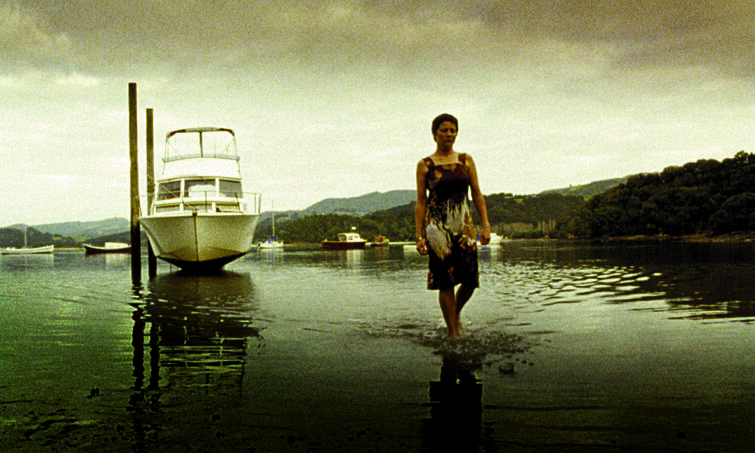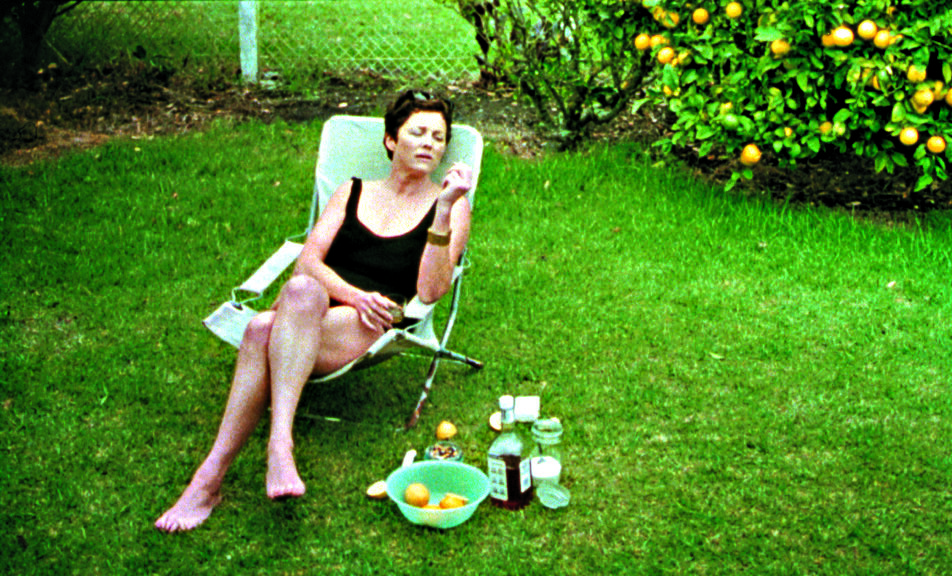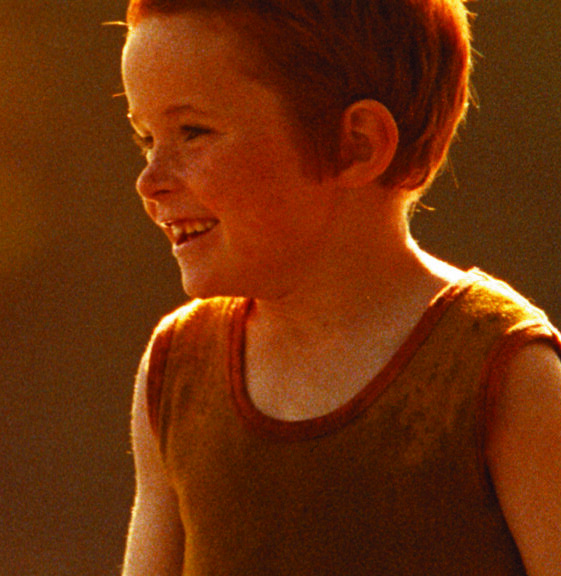Housewife Implosions in Rain
In the opening scenes of Rain (Christine Jeffs, 2001), the funky, evocative soundtrack combines with the slow motion drawl of a hand-pushed lawn mower to seduce the viewer into relating to the rhythms of lazy summer days. Although these are the days of a specific childhood in 1972, they also appear universal and timeless. Occupying the time and space of memory in general, this is the ‘bach’ (holiday house) that dad built, and this is the family that spends every summer holiday on the verandah or the beach.
However, as indicated by the first lines of dialogue, ‘It was sunny … mostly’ and ‘our house was on the water … well … nearly’, there is something slightly awry with the family that has come for yet another year to the ‘bach’ that they know as well as they know each other. This ‘mostly’ and ‘nearly’ indicate a disruption from the norm that cannot easily be explained away. Indeed, this disruption comes to embody the centrally destabilizing theme of defamiliarization that runs throughout the film. The directorial debut for Christine Jeffs, Rain is narrated from the perspective of 13-year-old Janey (Alicia Fulford-Wierzbicki), who becomes aware that her mother, Kate (Sarah Peirse), is having an affair with itinerant photographer, Cady (Marton Csokas). Herself playing on the fringes of adulthood, Janey begins to experience the disruption that will eventually envelop her father, Ed (Alistair Browning), and her younger brother, Jim (Aaron Murphy), too. Despite the idyllic surroundings, the viewer gets the sense that this family is on the verge of breakdown.
Whilst the summer days are filled with quietude for the adults and swimming, games and laughter for the children, the family’s fragmentation is heralded by the scenes of raucous, racy nighttime parties that fill the viewer with feelings of concern and alarm. With alcohol flowing liberally, the children are physically present but somehow invisible and forgotten by the adults. Allowed to do their own thing, they become witness (or victim) to inappropriate and frightening adult conversations and behaviour that is beyond their proper comprehension. They see Cady and Kate flirt with each other while other guests recklessly dash off for swims in the midnight sea. Drunk, the adults perform in strangely menacing ways as their bodies contort in rhythm with the records being played.
Rain’s party scenes call to mind the terrible parties of Once Were Warriors (Lee Tamahori, 1995), where people dance and sing, while teenage daughter Grace (Mamaengaroa Kerr-Bell) is abused by an uncle in another room. In Rain, this threat is suggested when an inebriated friend of her parents speaks to Janey whilst mixing cocktails. In both these important New Zealand films, the narrative reveals the family unit to be at risk of a domestic disturbance that is put into play by outsiders, but which only happens because the family itself is already in the process of imploding. The conditions for this destruction have already been well-established by Kate and Ed’s drinking and inactivity in Rain, and by socio-economic depression and drinking in Once Were Warriors. Indeed, the family in Rain is in many ways the white, middle-class equivalent of the Heke family. Despite their socio-economic privilege (the ‘bach’ they holiday in occupies a spot of exquisite beauty, and images of this echo the scene of natural beauty that is familiar to the Heke’s only through the billboard image that is positioned nearby their council home alongside an urban motorway), they are represented as being subject to many of the same internal pressures.

Located within a ‘domestic disturbance’ genre of cinema, Rain has similarities with films that include The Ice Storm (Ang Lee, 1997), and Cape Fear (Martin Scorsese, 1991). Not only do these films all tell respective stories of family disintegration, they focus on illustrating what happens to the small, nuanced everyday moments that continue (the dishes are washed, and the lawns mowed) despite the disturbance that reframes the family unit. These films all map the processes involved in the fragmentation and implosion of a nuclear family unit. While the disintegration is provoked by the incursion of an interloper into the space, home, or imagination of the family unit, this provocation is – in every case – merely an aggravation of a pre-existing set of cracks and vulnerabilities.
In particular, Rain and Cape Fear indicate the role that the everyday plays within the space of disturbance or disintegration. Both films are narrated retrospectively by adolescent daughters Janey and Danielle (Juliette Lewis), who herald each film’s conclusion with a brief comment referring to the continuation of their lives following—and despite—the disturbance that caused their family’s implosion. Both films end with the families’ return to the city, away from the disruption, and while Danielle explains that the disturbance was so great that she would be unable to talk about it or to assimilate it properly into her everyday life, the feeling of loss is much less ephemeral for Janey, who ends the film by repeating the definition for ‘endurance’ that she had used earlier in the film to explain something to Jim. Endurance is ‘holding on … It’s holding on’, she says finally, ‘and now it’s my turn’. Rather than remaining unspeakable in the case of Rain, the disturbance becomes part of their continuing and practical everyday: ‘So then we just went on’, she concludes.
Despite differences in their details, the disturbances in Rain and Cape Fear are caused by the incursion of an adult man into domestic family space in general, and into the space of adolescence in particular. In each case, the man’s sexuality combines uncomfortably with that of the teenage daughter, and in both cases (as if they were modern-day parables), the evocation of this sexuality provokes the ultimate breakdown of the discrete family unit. That this fragmentation is caused in both cases by a man called ‘Cady’ is a somewhat eerie coincidence.
As the outsider character in Rain, Cady is a shady character. He has little dialogue, is onscreen infrequently, and the viewer seems at times encouraged to perceive him as a figment of the family’s collective imagination. Cady’s strange immateriality is interesting, because it indicates that the character is less important and less central than the series of family disturbances that he contributes in aggravating. However, while Cady physically occupies the space of an outsider (hovering on the fringes of the action rather than being directly implicated as a central figure), the effects that he puts into play are enormous. These effects are echoed at a formal level in the film, and Jeffs articulates the input and significance of this character’s actions by giving the film an extremely photographic treatment. In reference to Cady’s profession as a photographer, the film’s cinematography draws extensively on the signifiers and paradigms of arthouse photography including the use of nostalgic sepia tones and almost still grainy black and white moments. The overtly ‘photographic’ scenes become surreal at times. Rather than being self-indulgent on the part of this film-maker (who is also a television commercial director), they are effective because they represent the disturbance as a series of jarring experiences that cannot be properly comprehended in narrative terms.

Just as Neil Finn’s wonderful (debut) soundtrack functions as a character in the film that the viewer turns to for additional narrative information, photography plays an important role in contextualizing the images evoked by the film. Not only are the meanings of these filmic images contributed to by photographic referents beyond the diegetic field, these extra-textual referents assist the viewer’s interpretation of particular situations and events. For instance, Janey is frequently represented in the film in a manner that evokes characters from Bill Henson’s controversial photographs of teenagers. During the nighttime parties, in particular, the lighting makes her appear hot, greenish and sticky, and this impression is heightened by the poorly applied eye make-up that she has worn specially to impress Cady. Another example is the images of Kate at home. Whether collapsed on the couch after a night’s drinking, drunkenly applying her lipstick under fluorescent bathroom lighting, or reclining in her swimming costume in a chair on the outside lawn with a large bottle of tequila, a jug of ice and several lemons littering the area around her feet, Kate embodies Cindy Sherman’s photographs of housewives and other female stereotypes. Perhaps because they resist making her an image of mockery or parody, these scenes that represent Kate alone in domestic spaces and moments are amongst the most resonant and affective of the film. The film’s consideration of photography draws attention not only to the aspects of image or film construction in general, but to the way in which identity itself is produced according to various practices and performances.
Ostensibly, Rain is impressive because it is evocative and visually astute, with an engaging soundtrack. However, it is also successful because it draws on and explores an array of cultural images, metaphors and models that are already familiar to viewers. For instance, it invokes the suburban ideal, as well as the picture postcard nostalgia associated with memories of childhood holidays at the beach. However, it disrupts these dream-images, by showing not only the mundane domestic everyday realities of mowing the lawn and doing the dishes, but by revealing the cracks and pressures that often become apparent at such times of family isolation. While these disruptions and pressures do constitute a nightmare, it is a nightmare that cannot be woken from. Instead, memories of the past events contribute to the ongoing lives of the characters who return from their holiday and continue on with their everyday lives. Rain is a remarkable and rewarding film for the viewer who can relate to the cinematic action primarily through their own understanding of family dynamics, as well as through their own memories of childhood summers. Not only does this film catch the mood of beach summers now gone, it takes the viewer on a journey that is both poignant and special.





